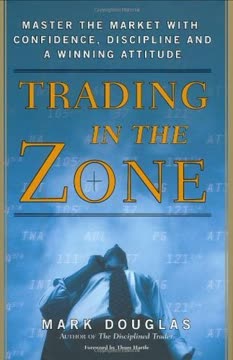Key Takeaways
1. Simplicity and Focus: Choose Uncomplicated Investments
Do what's easy and obvious, advises Buffett; don't try to develop complicated answers to complicated questions.
Embrace simplicity. Warren Buffett's investment philosophy is rooted in the belief that successful investing doesn't require complex formulas or advanced degrees. Instead, it relies on common sense principles and patience. Buffett advocates for investing in easy-to-understand, solid businesses with enduring prospects and capable management.
Avoid complexity. Buffett warns against getting caught up in sophisticated stock-picking programs, complicated mathematical formulas, or cutting-edge investment theories. He believes these often work against investors, creating unnecessary confusion and leading to poor decision-making. Instead, focus on:
- Buying stock in great companies run by honest and capable people
- Paying less for your share of the business than it's actually worth
- Holding onto that stock and waiting for the market to confirm your assessment
By sticking to these simple principles, Buffett has turned relatively small investments into billion-dollar holdings, demonstrating that extraordinary results don't require extraordinary actions.
2. Independent Thinking: Ignore Market Noise and Make Your Own Decisions
Figure it out for yourself.
Think for yourself. Buffett strongly believes that the average person is capable of investing successfully without relying on brokers, stock market pundits, or any other professionals. He argues that these so-called experts often bring nothing to the party and may even have conflicting interests due to their compensation structures.
Develop your own perspective. To invest like Buffett:
- Gain basic knowledge of accounting and financial markets
- Approach financial advisors and "talking heads" with healthy skepticism
- Remember that no one has a better investment record than Buffett himself
By understanding and applying Buffett's ideas and practices, you can develop a code of conduct that allows you to make sound investment decisions independently, without needing the services of anyone else.
3. Temperament: Stay Calm During Market Volatility
If you're someone who is likely to come unglued when one of your holdings loses half its value overnight, you shouldn't be in the stock market in the first place.
Cultivate emotional stability. Buffett emphasizes that having the right temperament is crucial for successful investing. This means keeping your head during both market highs and lows, and not letting emotions drive your investment decisions.
Stay rational during turbulence. To develop the proper temperament:
- Don't panic-sell when stock prices fall; instead, see it as a potential buying opportunity
- Focus on the long-term fundamentals of the businesses you own, not short-term price fluctuations
- Avoid making hasty decisions based on market sentiment or "expert" predictions
- Know yourself and your risk tolerance; don't invest in stocks you can't stomach holding through volatility
Remember, Buffett sees market downturns as opportunities to buy great companies at discounted prices. By maintaining a calm and rational approach, you can turn market volatility into an advantage rather than a threat to your investments.
4. Patience: Invest for the Long-Term, Not Short-Term Gains
Think 10 years, rather than 10 minutes, advises Buffett. If you aren't prepared to hold a given stock for a decade, don't buy it in the first place.
Adopt a long-term perspective. Buffett's investment philosophy is based on patience and a long-term outlook. He is a "decades trader" rather than a day trader, often holding onto shares for years or even decades. This approach allows him to benefit from the compounding growth of great businesses over time.
Practice disciplined patience. To invest like Buffett:
- Buy stocks with the intention of holding them for at least 5-10 years
- Focus on the business performance rather than daily stock price movements
- Resist the urge to trade frequently, which can lead to higher costs and lower returns
- Be willing to wait for the right opportunity to invest in great companies at fair prices
Buffett's patience has allowed him to turn relatively small investments into billion-dollar holdings. By adopting this long-term mindset, you can avoid the pitfalls of short-term thinking and potentially reap significant rewards over time.
5. Business-Centric Approach: Buy Great Companies, Not Just Stocks
Remember that a stock is a piece of a business. Don't buy a stock because of its price action; buy a stock based on analysis of the business and its future prospects.
Focus on the underlying business. Buffett emphasizes that when you buy a stock, you're buying a piece of an actual business. Therefore, your investment decisions should be based on the quality and prospects of the business itself, not just stock price movements or market trends.
Analyze businesses, not just stocks. To implement this approach:
- Study the company's fundamentals: profits, earnings, cash flow, balance sheets, and income statements
- Evaluate the company's competitive advantages and long-term growth potential
- Assess the quality and integrity of the management team
- Look for businesses with predictable and durable earnings power
- Use online resources to research companies thoroughly before investing
By focusing on the business behind the stock, you can make more informed investment decisions and potentially identify great companies that will create value for shareholders over the long term.
6. Concentrated Portfolio: Invest Heavily in Few High-Quality Businesses
Buy 5 to 10 good companies at a bargain price and buy as large a position in each as you can.
Focus on your best ideas. Contrary to conventional wisdom that advocates for broad diversification, Buffett recommends concentrating your investments in a small number of high-quality businesses. He believes that if you've found the right stock, you should invest heavily in it rather than diluting your returns across many mediocre investments.
Build a concentrated portfolio. To implement this strategy:
- Aim to own no more than 10 stocks in your portfolio
- Invest significantly in each position when you have high conviction
- Ensure that each investment meets Buffett's criteria for great businesses with strong management
- Be patient and wait for the right opportunities to invest
- Have the courage to act decisively when you identify a great investment opportunity
Buffett's concentrated approach has allowed him to generate exceptional returns over time. By focusing on your best ideas and investing heavily in them, you can potentially outperform a more diversified but mediocre portfolio.
7. Inactivity: Resist the Urge to Constantly Buy and Sell
Lethargy? Inactivity? Snoring your way to riches? What's going on here? Isn't investing all about life in the fast lane?
Embrace inactivity. Buffett believes that excessive trading is hazardous to your wealth. He advocates for a buy-and-hold strategy, where investors purchase shares in great businesses and hold onto them for long periods, resisting the urge to constantly buy and sell based on short-term market movements.
Practice intelligent inactivity. To implement this approach:
- Avoid frequent trading, which incurs transaction costs and potential tax liabilities
- Focus on the long-term performance of your businesses rather than short-term price fluctuations
- Be patient and wait for truly exceptional investment opportunities
- Don't feel pressured to always be "doing something" with your portfolio
- Remember that inactivity can be a sign of investing brilliance
Buffett has demonstrated the power of this approach by holding onto many of his investments for decades, allowing them to compound in value over time. By resisting the urge to constantly trade and instead focusing on owning great businesses for the long term, you can potentially achieve better investment results and minimize costs.
8. Value Investing: Look for Undervalued Companies with Strong Fundamentals
Value investing consists chiefly of acting on discrepancies between price and value in the stock market: the figurative search for dollar bills that are selling for 40 cents.
Seek undervalued opportunities. Buffett's investment philosophy is rooted in value investing, a strategy pioneered by his mentor Benjamin Graham. This approach involves identifying companies whose stock prices are significantly lower than their intrinsic value, creating opportunities for substantial returns.
Implement value investing principles. To invest like Buffett:
- Focus on the company's fundamentals rather than short-term market trends
- Look for businesses with strong competitive advantages and consistent earnings
- Analyze financial statements to assess the company's true value
- Be patient and wait for the market to offer attractive prices on quality businesses
- Don't be swayed by market hype or popular opinion; trust your own analysis
Value investing requires discipline and a willingness to go against the crowd. By focusing on finding undervalued companies with strong fundamentals, you can potentially achieve superior returns over the long term, just as Buffett has done throughout his career.
9. Margin of Safety: Buy Stocks at a Discount to Their Intrinsic Value
Simply put, "margin of safety" means that the price of the stock is substantially lower than the value of the business.
Prioritize safety. Buffett emphasizes the importance of having a significant margin of safety when investing. This concept, also derived from Benjamin Graham, involves buying stocks at a price substantially below their intrinsic value, providing a buffer against potential errors in valuation or unforeseen negative events.
Implement the margin of safety principle. To apply this concept:
- Always seek a substantial discount between the stock price and your estimate of the business's intrinsic value
- Be patient and wait for opportunities when market pessimism creates attractive prices
- Don't compromise on quality; look for great businesses selling at a discount
- Remember that a larger margin of safety reduces risk and increases potential returns
- Be prepared to act decisively when such opportunities arise
By consistently applying the margin of safety principle, you can potentially reduce your investment risk while positioning yourself for significant gains when the market eventually recognizes the true value of the business.
10. Continuous Learning: Read Extensively and Think Critically
Extensive reading arms Buffett with the facts and ideas that fuel his independent thinking and reasoning.
Cultivate knowledge. Buffett attributes much of his success to his voracious reading habit and his ability to think critically about the information he consumes. He spends a significant portion of each day reading financial publications, annual reports, and books on investing and business.
Develop a learning habit. To emulate Buffett's approach:
- Read extensively, focusing on high-quality sources of financial and business information
- Study annual reports and financial statements of companies you're interested in
- Read books by and about successful investors, particularly Benjamin Graham and Philip Fisher
- Avoid wasting time on market forecasts, stock tips, or complex theoretical models
- Take time to think critically about what you've read and how it applies to your investments
By continuously expanding your knowledge and honing your critical thinking skills, you can develop the intellectual framework necessary for successful long-term investing. Remember, in Buffett's view, the investment industry is one where knowledge accumulates and rewards those willing to put in the effort to uncover it.
Last updated:
FAQ
What's "How Buffett Does It" about?
- Overview of the book: "How Buffett Does It" by James Pardoe outlines 24 simple investing strategies inspired by Warren Buffett, the world's greatest value investor.
- Focus on simplicity: The book emphasizes the importance of simplicity in investing, advocating for straightforward strategies over complex ones.
- Value investing principles: It delves into the core principles of value investing, a method that Buffett has mastered over decades.
- Practical advice: The book provides actionable advice for investors looking to emulate Buffett's success in the stock market.
Why should I read "How Buffett Does It"?
- Learn from the best: The book distills the wisdom of Warren Buffett, offering insights from one of the most successful investors in history.
- Actionable strategies: It provides practical, easy-to-follow strategies that can be applied by both novice and experienced investors.
- Avoid common pitfalls: By understanding Buffett's approach, readers can avoid common investing mistakes and improve their financial decision-making.
- Long-term success: The book emphasizes patience and discipline, key traits for achieving long-term investment success.
What are the key takeaways of "How Buffett Does It"?
- Simplicity over complexity: Buffett advises keeping investment strategies simple and avoiding unnecessary complexity.
- Independent thinking: Investors should make their own decisions and not be swayed by market trends or popular opinion.
- Focus on value: The book stresses the importance of buying undervalued stocks and holding them for the long term.
- Proper temperament: Maintaining a calm and patient demeanor is crucial, especially during market fluctuations.
What is Warren Buffett's investment philosophy as described in the book?
- Value investing: Buffett focuses on buying undervalued stocks of companies with strong fundamentals and holding them long-term.
- Business analysis: He emphasizes understanding the business behind the stock, rather than just the stock price.
- Margin of safety: Buffett looks for a significant gap between a stock's price and its intrinsic value to minimize risk.
- Patience and discipline: He advocates for a patient approach, waiting for the right opportunities and avoiding impulsive decisions.
How does "How Buffett Does It" suggest handling market downturns?
- Buying opportunities: Market downturns are seen as opportunities to buy quality stocks at discounted prices.
- Ignore short-term noise: Investors should focus on the long-term value of their investments rather than short-term market fluctuations.
- Stay calm: Maintaining composure during market volatility is crucial to making rational investment decisions.
- Mr. Market concept: The book uses Ben Graham's "Mr. Market" allegory to illustrate how investors can benefit from market irrationality.
What does "How Buffett Does It" say about diversification?
- Concentration over diversification: Buffett prefers concentrating investments in a few well-researched stocks rather than diversifying widely.
- Focus on best ideas: By investing heavily in a few top choices, investors can maximize returns on their best ideas.
- Risk management: While diversification is a common risk management strategy, Buffett believes in understanding and managing risk through thorough research.
- Quality over quantity: The emphasis is on owning a smaller number of high-quality stocks rather than a large, diluted portfolio.
What role does independent thinking play in Buffett's strategy according to the book?
- Avoid herd mentality: Independent thinking helps investors avoid following the crowd, which can lead to poor investment decisions.
- Rely on facts and reasoning: Decisions should be based on solid research and analysis rather than popular opinion or trends.
- Long-term focus: Independent thinkers are more likely to focus on long-term value rather than short-term market movements.
- Confidence in decisions: By thinking independently, investors can have confidence in their investment choices, even when they go against the grain.
How does "How Buffett Does It" define a "circle of competence"?
- Zone of expertise: A circle of competence refers to the industries and businesses an investor thoroughly understands.
- Stay within boundaries: Investors should focus on opportunities within their circle and avoid venturing into unfamiliar areas.
- Importance of knowledge: Understanding a business's fundamentals is crucial for making informed investment decisions.
- Avoiding mistakes: Staying within one's circle of competence helps minimize the risk of making poor investment choices.
What is the "margin of safety" concept in "How Buffett Does It"?
- Price vs. value: The margin of safety is the difference between a stock's market price and its intrinsic value.
- Risk reduction: A significant margin of safety reduces the risk of loss by providing a buffer against market volatility.
- Investment criteria: Buffett looks for stocks with a large margin of safety to ensure a favorable risk-reward ratio.
- Long-term success: This concept is central to value investing and helps investors achieve long-term financial success.
What are some of the best quotes from "How Buffett Does It" and what do they mean?
- "Choose simplicity over complexity": This quote emphasizes the importance of straightforward investment strategies that are easy to understand and implement.
- "Be fearful when others are greedy and greedy when others are fearful": It highlights the contrarian approach of taking advantage of market emotions to find investment opportunities.
- "Buy businesses, not stocks": This underscores the importance of focusing on the underlying business rather than just the stock price.
- "Practice inactivity, not hyperactivity": It advises investors to avoid frequent trading and instead hold onto quality investments for the long term.
How does "How Buffett Does It" suggest evaluating management?
- Shareholder alignment: Assess whether management's interests align with those of shareholders, avoiding excessive compensation and perks.
- Frugality and efficiency: Look for management teams that are cost-conscious and focused on improving shareholder value.
- Transparency and honesty: Evaluate the clarity and honesty of financial reporting and communication with shareholders.
- Track record: Consider management's past performance and ability to navigate challenges effectively.
What are the common mistakes to avoid according to "How Buffett Does It"?
- Overdiversification: Spreading investments too thinly can dilute potential returns and complicate portfolio management.
- Following the herd: Avoid making investment decisions based on popular trends or market hype.
- Ignoring fundamentals: Focus on the intrinsic value of businesses rather than short-term price movements or speculative opportunities.
- Lack of patience: Impatience can lead to poor decision-making and missed opportunities for long-term growth.
Review Summary
How Buffett Does It receives mixed reviews, with an average rating of 3.98 out of 5. Many readers find it a simple, easy-to-understand introduction to Warren Buffett's investing strategies, praising its concise format and clear explanations. Some appreciate its focus on value investing principles and Buffett's long-term approach. However, critics argue that it lacks depth, is repetitive, and offers little new information for those already familiar with Buffett's methods. Several reviewers recommend it as a starting point for novice investors but suggest more comprehensive resources for in-depth learning.
Similar Books










Download PDF
Download EPUB
.epub digital book format is ideal for reading ebooks on phones, tablets, and e-readers.




